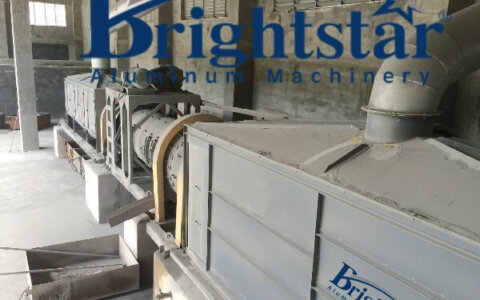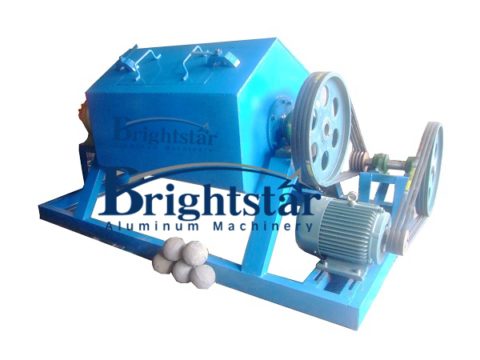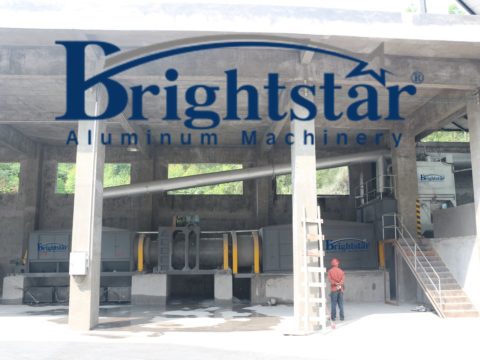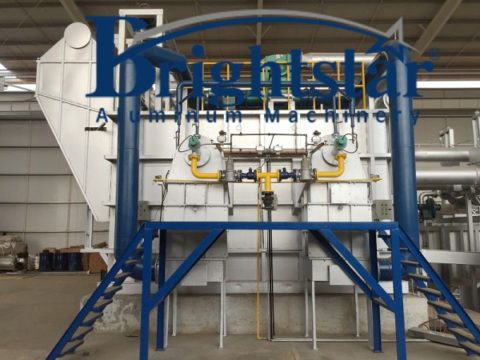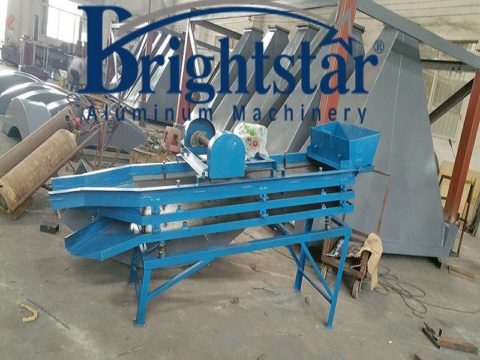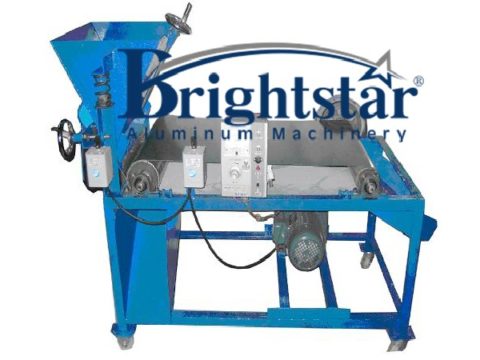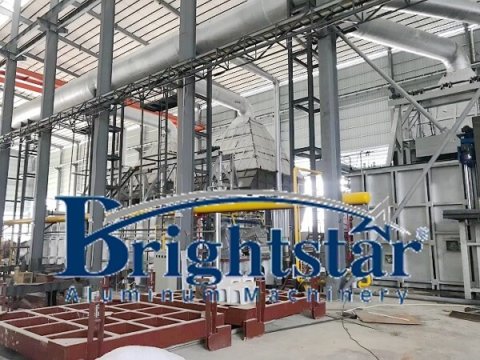
Cold aluminium dross ball mill and sieving machine
Cold aluminium dross ball mill and sieving machine
Cold aluminium dross ball mill and sieving machine
Cold aluminium dross ball mill and sieving machine include ball mill and sieving machine.
The main purpose is to crush and grind cold dross and sieve in different grades and separate in coarse, medium and fine dross.
The coarse aluminium dross can be recycled in the melting furnace, the medium dross can be used in the dross processing machine for the cooling or rotary furnace, the fine dross will be bagged for sales.
The completed system and total solution for cold aluminium dross recycling
This increases the surface area of the dross, making it easier to separate the aluminum from the impurities during the next stage.
Process: The ball mill is a cylindrical chamber filled with steel balls of varying sizes.
As the chamber rotates, the balls tumble and crush the dross against the inner lining and against each other.
The size of the balls and the speed of rotation can be adjusted to achieve the desired particle size.
Aluminum Dross Screening:
Function: After the dross is ground in the ball mill, it is passed through a series of vibrating screens to separate it into different size fractions.
The screens have mesh sizes that allow particles of different sizes to pass through.
Separation: Typically, there are three or four screens with varying mesh sizes.
The largest screen allows the largest aluminum particles to pass through, while the smallest screen allows only the finest powder to pass through.
The intermediate screens capture particles of different sizes in between.
Benefits: Separating the dross into different sizes facilitates further processing and utilization.
Larger particles can be directly remelted, while smaller particles may be used for other applications such as casting alloys or in the construction industry.
Overall, the aluminum dross ball mill and screening machine work together to efficiently process aluminum dross and recover valuable metal.
By crushing and grinding the dross, and then separating it into different sizes, the system maximizes the recovery of aluminum while minimizing waste.
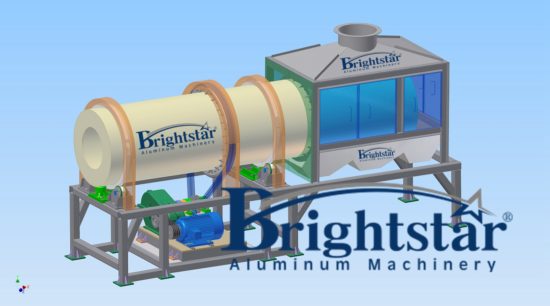
Cold aluminium dross ball mill and sieving machine design
Working process of cold aluminium dross ball mill and sieving machine
Cold dross( natural cooling or cooling machine)→hopper→ball mill(crushing and grinding) →sieving machine( coarse, medium and fine dross, coarse dross will be recycled in the melting). One completed cycle for aluminium dross recycling.
System description
Cold aluminium dross ball machine is designed as a high-tech machine based on aluminium dross composition and nature, which can separate aluminium from dross effectively, grind more high purity aluminium, reduce aluminium loss, improve aluminum recovery rate greatly.
The high efficiency and low maintenance rate of the ball mill will guarantee the long stable running of aluminium dross production line; it can bring more profit to the factory.
The main function of aluminium dross sieving machine is separating and screening different sizes of aluminium dross, which is crushed and ground by a ball mill and the dross is generated from the furnace and it is cold dross after cooling. This can improve the aluminium recovery rate in aluminium recycling.
Aluminum dross sieving machine function
To recover the crushed and ground aluminum dross effectively, we use the sieving barrel to screen the aluminium dross in different grades, which can recycle aluminium in different grades better, and the aluminium recovery rate will be high.
Technical data of cold aluminium dross ball mill and sieving machine
Processing quantity 5-20 tons per day up to the project
Speed: 23 r/min for Ball Mill, 8-12r/min for Sieving Machine
The Necessity of Aluminum Dross Ball Mill and Sieving Machine in Aluminum Dross Processing
While not inherently necessary in every single case, a ball mill and sieving machine play a crucial role in optimizing aluminum dross processing for several reasons:
Increased Aluminum Recovery:
Improved separation: Grinding dross increases the surface area, facilitating the extraction of valuable aluminum trapped within the non-metallic impurities.
By crushing and sieving, you unlock more aluminum for potential recovery.
Targeted processing: Separating dross into different sizes allows for targeted processing methods based on particle size.
Larger pieces can be directly remelted, while smaller ones might undergo further refining or be used for other applications.
This optimizes resource utilization and minimizes waste.
Enhanced Efficiency and Cost Savings:
Improved handling: Dross becomes easier to handle and transport after size reduction.
Smaller particles also feed more efficiently into further processing equipment, like furnaces or separators.
Energy savings: Smaller dross particles require less energy to melt and process compared to larger chunks, leading to potential cost savings in furnace operation.
Faster processing: Grinding and sieving can increase the overall processing speed of the dross, leading to improved throughput and potentially higher production capacity.
Improved Product Quality:
Reduced contamination: Sieving helps remove undesirable impurities and contaminants from the recovered aluminum, leading to a purer metal with better properties. This can enhance the quality of final products made with recycled aluminum.
Specific applications: Different dross sizes cater to different applications.
For example, fine aluminum powder from sieving can be used in specific casting alloys or construction materials.
However, the necessity of a ball mill and sieving machine can depend on several factors:
Dross composition: If the dross already has a small particle size and relatively low aluminum content, grinding and sieving might not offer significant benefits.
Processing goals: If the goal is only to recover large aluminum pieces for immediate remelting, additional size reduction might not be necessary.
Cost considerations: Ball mills and sieving machines require investment and operational costs. Evaluating the potential cost savings and recovered aluminum value is crucial to determine their financial viability.
In conclusion, while not mandatory in every scenario, a ball mill and sieving machine represent a valuable tool in most aluminum dross processing setups.
They enhance aluminum recovery, optimize efficiency, and contribute to improved product quality.
However, a thorough evaluation of specific dross characteristics, processing goals, and cost considerations is necessary to determine their optimal implementation within your operation.
The importance of aluminium dross ball mill and sieving machine in dross recycling
The aluminum dross ball mill and sieving machine play a crucial role in dross recycling, significantly impacting the efficiency, sustainability, and profitability of the process. Here’s a breakdown of their importance:
Increased Aluminum Recovery:
Improved separation: Grinding the dross in the ball mill liberates trapped aluminum from non-metallic impurities, maximizing recoverable metal. Sieving further refines the dross by separating different particle sizes, allowing for targeted processing of each fraction. This can lead to recovery rates exceeding 90%, minimizing waste and maximizing resource utilization.
Targeted processing: Larger aluminum pieces from sieving can be directly remelted, while smaller particles may be used for different applications like casting alloys or construction materials. This increases the overall value extracted from the dross, reducing waste and creating new revenue streams.
Enhanced Efficiency and Cost Savings:
Improved handling: Grinding and sieving reduce the dross to a more manageable size, making it easier to transport, store, and feed into processing equipment. This results in reduced labor costs and operational downtime.
Energy savings: Smaller dross particles require less energy to melt and process compared to larger chunks, leading to significant cost savings in furnace operation.
Faster processing: The smaller particle size also translates to faster processing through various stages, potentially increasing production capacity and overall throughput.
Improved Environmental Impact:
Reduced virgin aluminum production: Increased dross recycling lowers the demand for virgin aluminum, which requires significant energy and raw materials to produce. This translates to reduced greenhouse gas emissions and resource consumption.
Decreased landfilling: By extracting more aluminum from dross, less waste ends up in landfills, minimizing environmental pollution and land degradation.
Overall, the aluminum dross ball mill and sieving machine are essential tools for optimizing dross recycling.
They enable higher recovery rates, improve efficiency and profitability, and contribute to a more sustainable aluminum industry.
While their necessity may depend on specific dross characteristics and processing goals, their impact on environmental and economic factors makes them a sound investment for most recycling operations.
We will design, manufacture based on your production situation and from design, manufacturing, delivery to installation, commissioning, training, technical support and service, one-stop service and we do more than you expected.
Contact us now to obtain a reliable no-obligation quote on your cold aluminium dross recycling system.
